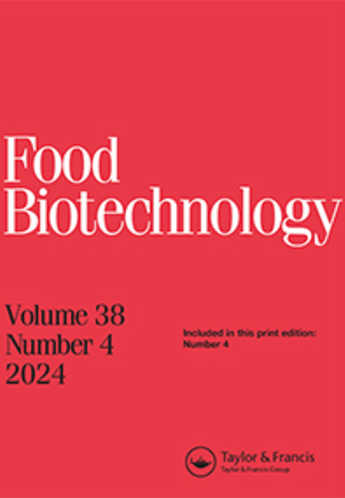茅台酒堆垛发酵阶段产二乙酰微生物组分析及随机森林算法辅助鉴定
IF 1.6
4区 农林科学
Q4 BIOTECHNOLOGY & APPLIED MICROBIOLOGY
引用次数: 3
摘要
摘要双乙酰基赋予食品和饮料一种独特的黄油香气。然而,当它在酱香型白酒中含量很高时,会产生一种不理想的黄油味。本研究的目的是鉴定酱香型白酒中产生双乙酰的微生物,最终目的是开发减少双乙酰产生的方法。为了探讨酱香型白酒中二乙酰的微生物来源,对酱香型酒生产中使用的叠层发酵糟的异味强度和二乙酰含量进行了评价。然后,将16S rRNA V3-V4高通量测序和随机森林算法相结合,分析潜在的二乙酰生产商。特征筛选结果表明,乳酸杆菌是发酵谷物中二乙酰的主要贡献者,其次是葡萄球菌、Weissella、Pediococcus和克雷伯菌。为了验证这一点,从高双乙酰异味组样品中选择了123个乳酸菌(LAB)分离株,乳酸杆菌属占已鉴定分离株的90%以上。我们的研究结果表明,植物乳杆菌、戊糖乳杆菌和发酵乳杆菌是主要的二乙酰产生微生物(>90mg/L)。此外,高产菌株植物乳杆菌MTL-09的发酵特性表明,温度和pH对二乙酰的产生有很大影响,这可能为通过控制发酵过程中的pH或温度来抑制异味提供了一种策略。该方法还可用于鉴定发酵食品和酒精饮料的关键微生物。本文章由计算机程序翻译,如有差异,请以英文原文为准。
Microbiome analysis and random forest algorithm-aided identification of the diacetyl-producing microorganisms in the stacking fermentation stage of Maotai-flavor liquor production
ABSTRACT Diacetyl imparts a characteristic buttery aroma to foods and beverages. However, when present at high levels in Maotai-flavor liquor, it generates an undesirable buttery off-odor. The aim of this study was to identify the diacetyl-producing microorganisms in Maotai-flavor liquor with an ultimate aim to develop methods that could reduce diacetyl production. To explore the microbial origin of diacetyl in Maotai-flavor liquor, the off-odor intensity and diacetyl content of stacking fermented grains, which are used in the production of Maotai-flavor liquor, were evaluated. Then, 16S rRNA V3-V4 high-throughput sequencing and the random forest algorithm were combined to analyze the potential diacetyl producers. The featured selection results indicated that Lactobacillus was the major diacetyl contributor in the fermented grains, followed by Staphylococcus, Weissella, Pediococcus, and Klebsiella. To verify this, 123 lactic acid bacteria (LAB) isolates were selected from the high diacetyl off-odor group samples, and the genus Lactobacillus accounted for more than 90% of the identified isolates. The results of our study showed that L. plantarum, L. pentosus, and L. fermentum were the major diacetyl-producing microorganisms (>90 mg/L). Moreover, the fermentation characteristics of the high-yield strain, L. plantarum MTL-09, showed that temperature and pH had strong effects on diacetyl production, which may offer a strategy for inhibiting the off-odor by controlling the pH or temperature during fermentation. The methods may also be useful for identification of key microorganisms for fermented foods and alcoholic beverages.
求助全文
通过发布文献求助,成功后即可免费获取论文全文。
去求助
来源期刊

Food Biotechnology
工程技术-生物工程与应用微生物
CiteScore
3.80
自引率
0.00%
发文量
15
审稿时长
>12 weeks
期刊介绍:
Food Biotechnology is an international, peer-reviewed journal that is focused on current and emerging developments and applications of modern genetics, enzymatic, metabolic and systems-based biochemical processes in food and food-related biological systems. The goal is to help produce and improve foods, food ingredients, and functional foods at the processing stage and beyond agricultural production.
Other areas of strong interest are microbial and fermentation-based metabolic processing to improve foods, food microbiomes for health, metabolic basis for food ingredients with health benefits, molecular and metabolic approaches to functional foods, and biochemical processes for food waste remediation. In addition, articles addressing the topics of modern molecular, metabolic and biochemical approaches to improving food safety and quality are also published.
Researchers in agriculture, food science and nutrition, including food and biotechnology consultants around the world will benefit from the research published in Food Biotechnology. The published research and reviews can be utilized to further educational and research programs and may also be applied to food quality and value added processing challenges, which are continuously evolving and expanding based upon the peer reviewed research conducted and published in the journal.
 求助内容:
求助内容: 应助结果提醒方式:
应助结果提醒方式:


